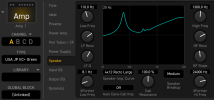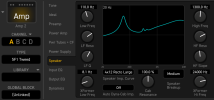Rex
Dignified but Approachable
That helps me understand.I guess it wasn't clear what I meant, I'll have another go...
POSSIBILITY 1
Choosing a SIC just presets the values of the numeric parameters. You can edit those parameters, which means the settings in effect don't correspond to the displayed SIC any more. The SIC setting itself has no effect except as a "preset" for those params.
POSSIBILITY 2
Choosing a SIC sets the underlying "mode" for this aspect of the modeling. You can edit the numeric parameters, but nothing you do will turn one SIC into another one, because the underlying operating "mode" is different. It's similar to amps and their settings. Copying the visible settings from a Deluxe to a Splawn won't make them the same, because a different amp model is in effect.
Is that clearer?
I'd love to know which of those possibilities is actually how it works. @FractalAudio?
While I don’t have enough information to make that call, I’ve noticed that some SICs have multiple peaks and valleys that aren’t accounted for by the available parameters, and some don’t. That would suggest that there’s something additional going on.

 ). I notice the following which is odd (maybe a bug?):
). I notice the following which is odd (maybe a bug?):

